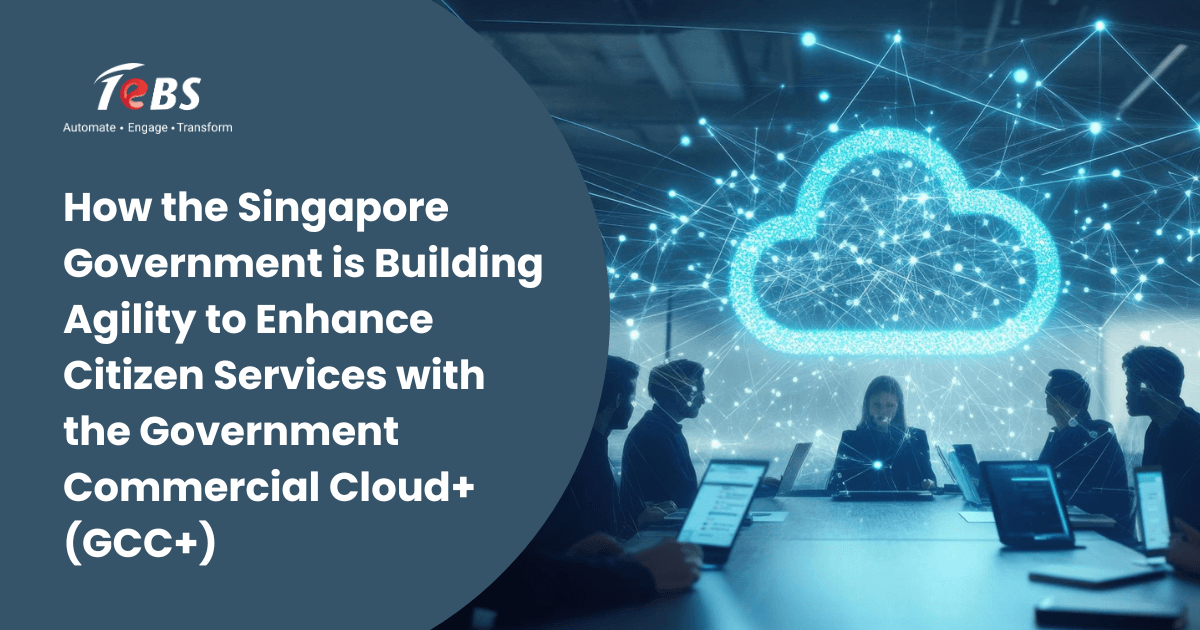Summary
Introduction
The Genesis of Government on Commercial Cloud (GCC)
The Singapore government’s journey to cloud computing began with the recognition that traditional IT systems were no longer sufficient to meet the increasing demand for digital services. Legacy infrastructures were costly, siloed, and difficult to scale. The GCC was created as a secure, government-focused cloud environment that supports compliance, efficiency, and innovation through AI automation and intelligent data governance frameworks.
In response, the Government on Commercial Cloud (GCC) was conceptualized as a secure, government-focused cloud environment. GCC provides a trusted platform for public agencies to host their applications and data while ensuring compliance with stringent security and data governance requirements. By leveraging GCC, agencies can avoid the pitfalls of disparate systems and benefit from standardized cloud services designed to meet public sector demands.
Strategic Objectives Driving the Cloud Transformation
The Singapore government’s move to cloud was guided by clear strategic objectives:- Operational Efficiency: Consolidating IT resources to reduce duplication, cost, and complexity while using AI intelligent automation for faster, streamlined operations. The cloud environment allows for on-demand access to computing power, storage, and networking capabilities, enabling agencies to scale according to service needs.
- Enhanced Security and Compliance: Public sector data is sensitive, and its protection is paramount. GCC provides a secure framework with robust access controls, encryption, and monitoring mechanisms. Agencies also benefit from compliance with local regulations and standards, ensuring that data sovereignty and integrity are maintained.
- Innovation and Agility: One of the most significant advantages of cloud adoption is the ability to innovate quickly. Agencies can experiment with new technologies, such as AI and analytics, without being constrained by on-premises infrastructure. Cloud-native services facilitate rapid prototyping and deployment of citizen-centric solutions.
- Inter-Agency Collaboration: Cloud infrastructure promotes seamless information sharing across departments. By breaking down data silos, the government can adopt a more integrated approach to service delivery, ultimately improving outcomes for citizens and businesses.
Challenges Faced on the Cloud Journey
While the benefits of cloud computing were clear, the transition was not without challenges. The Singapore government had to carefully navigate several critical issues:- Security Concerns: Moving sensitive citizen and government data to the cloud demanded rigorous security protocols. GCC addressed these concerns through robust security frameworks, continuous monitoring, and adherence to strict compliance standards.
- Change Management: Transitioning hundreds of agencies to a unified cloud platform required a cultural shift. Staff needed to adopt new processes, learn new skills, and embrace cloud-first mindsets. Training programs and workshops were critical in ensuring smooth adoption.
- Legacy System Integration: Many agencies relied on older applications that were not designed for cloud deployment. The government invested in modernizing or re-architecting these systems to function efficiently in a cloud environment.
- Cost Management: Although cloud computing can offer long-term savings, initial migration efforts involve upfront investments in planning, re-engineering, and staff training. Strategic planning and phased migration helped manage costs effectively.
Key Pillars of GCC’s Success
The Government on Commercial Cloud’s success is built on several foundational pillars:- Security and Trust: GCC is designed with security at its core. Multi-layered defense mechanisms, strict access controls, and end-to-end encryption ensure that data is protected against unauthorized access. Regular audits and certifications reinforce trust in the platform.
- Scalability and Flexibility: GCC offers scalable infrastructure that can support spikes in demand, such as during national initiatives or digital service rollouts. Agencies can provision resources on demand, avoiding the constraints of traditional IT procurement cycles.
- Interoperability and Standardization: GCC emphasizes standardized services and APIs, enabling agencies to integrate applications more easily and share data securely. This standardization reduces complexity and fosters a more collaborative ecosystem.
- Cloud-native Innovation: Leveraging AI Data Analytics & BI capabilities enables data-driven policymaking and service optimization. This empowers evidence-based policymaking and more targeted citizen services.
Real-World Impact of GCC
- Digital Service Enhancement: Agencies have been able to deploy citizen-facing digital services more quickly and efficiently. For instance, online platforms for permits, healthcare appointments, and social assistance have become more responsive and user-friendly.
- Operational Resilience: Cloud infrastructure has improved business continuity planning. During unforeseen events, such as system outages or emergencies, agencies can maintain critical operations with minimal disruption.
- Cost Optimization: Consolidating infrastructure under GCC has enabled significant cost savings through reduced hardware procurement, energy usage, and maintenance overhead.
- Data-Driven Policy Decisions: With improved access to integrated datasets, policymakers can make informed decisions based on real-time analytics. Cloud-hosted platforms facilitate predictive modeling, trend analysis, and scenario planning.
The Role of Partnerships and Collaboration
Singapore’s cloud journey has been strengthened by strategic collaborations with technology providers. By partnering with trusted vendors, the government has accessed advanced tools, expertise, and frameworks essential for large-scale cloud adoption. These collaborations also ensure that agencies can leverage cutting-edge innovations while adhering to strict security and compliance requirements.
This aligns with Gartner’s insights that secure, AI-empowered ecosystems define the future of public digital infrastructure.
Lessons Learned from the Journey
The Singapore government’s experience offers several valuable lessons for large-scale cloud adoption:- Define Clear Objectives: Success requires alignment around specific goals such as efficiency, security, and innovation. Clear objectives help prioritize investments and measure progress.
- Invest in Security Early: Incorporating security considerations from the outset mitigates risks and builds confidence among stakeholders. Security should be viewed as an enabler, not a constraint.
- Focus on Change Management: Technological transformation is as much about people as it is about systems. Providing adequate training, support, and communication ensures staff can adapt and thrive in a cloud-first environment.
- Phased Migration Works Best: Gradual, well-planned migration reduces operational disruption and allows agencies to learn from early experiences before scaling.
- Leverage Cloud-Native Capabilities: Beyond cost savings and scalability, cloud platforms offer unique tools for analytics, AI, and automation. Agencies that embrace these capabilities can drive meaningful innovation.
The Road Ahead: Expanding Cloud Adoption
- Enhanced AI and Analytics: Agencies will increasingly use AI-driven insights to anticipate citizen needs, optimize services, and improve policy outcomes.
- Cross-Agency Collaboration: Greater integration across departments will enable seamless end-to-end services, such as unified citizen profiles and interconnected platforms.
- Sustainability and Efficiency: Cloud adoption supports green IT initiatives by reducing physical hardware footprints and optimizing energy usage.
- Global Benchmarks: Singapore aims to maintain its leadership position in digital government by adopting international best practices and emerging technologies.
Case Study: Intelligent Cloud Integration in Action
See how TeBS enabled efficient digital transformation through secure automation in our case study: Enhancing Search Efficiency with AI-Powered Document Processing Solution.Conclusion
Singapore’s journey to the cloud demonstrates that ambitious digital transformation is achievable with careful planning, robust security, and a clear focus on innovation. The Government on Commercial Cloud (GCC) has not only modernized IT infrastructure but also empowered agencies to deliver responsive, efficient, and data-driven services to citizens. By aligning strategy, technology, and people, Singapore has set a benchmark for other nations seeking to embrace digital transformation securely and sustainably.
For organizations aiming to replicate such success or accelerate their cloud adoption journey, expert guidance is essential. Connect with the team at [email protected] to explore tailored solutions that help achieve scalable, secure, and innovative cloud transformations.
1. What is Singapore’s Government on Commercial Cloud (GCC)?
The Government on Commercial Cloud (GCC) is a secure cloud platform launched by Singapore’s Government Technology Agency (GovTech) that enables government agencies to host applications on commercial cloud services like AWS, Azure, and Google Cloud, ensuring agility, scalability, and compliance with public sector standards.
2. How did the Singapore government use AI and cloud technologies to improve public services?
The government leveraged AI and cloud technologies to enhance service delivery through predictive analytics, chatbots, automation, and real-time data processing—improving citizen engagement, operational efficiency, and policy decision-making.
3. What are the key benefits of the Government on Commercial Cloud (GCC) initiative?
Key benefits include faster deployment of digital services, improved scalability, reduced infrastructure costs, enhanced cybersecurity, and greater innovation through access to advanced cloud and AI tools.
4. How does AI enhance cloud security and data governance in Singapore’s public sector?
AI strengthens cloud security by enabling real-time threat detection, automated compliance monitoring, and intelligent access control. It also supports better data governance through pattern recognition and anomaly detection in sensitive datasets.
5. What challenges did Singapore face during its cloud transformation journey?
Challenges included managing data sovereignty, ensuring cybersecurity compliance, upskilling government staff, integrating legacy systems, and maintaining consistent governance across multiple cloud providers.





